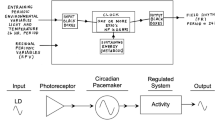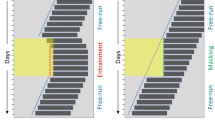Summary
Circadian stridulation rhythms of the male Australian field cricketTeleogryllus commodus (Walker) recorded in continuous light (LL) and constant temperature sometimes split spontaneously or after a pulse of low temperature into two activity components per cycle. Both components exhibited different free-running periods longer than 24 h, referring to separate oscillatory control mechanisms. One of the components disappeared when an optic lobe was removed.
Two activity components per circadian cycle with different periods were also found after the ommatidial nerves between retina and optic lobe had been cut on one side during the last larval instar. In LL, one period was then longer, the other shorter than 24 h; these periods correspond to the freerunning rhythms of intact crickets in LL and constant darkness (DD) (Loher 1972), and indicate that they can be simultaneously expressed in the same cricket. The two underlying pacemakers are only weakly coupled, they jointly or alternatingly influence the overt rhythm causing a spectrum of different patterns. Additional removal of the optic lobe on the intact side eliminated the LL-component (>24 h) while the DD-component (<24 h) continued. Removal of the de-afferented optic lobe had the reverse effect. Each component of the split activity rhythm can therefore be attributed to either side of the brain. The circadian control mechanism of the calling song inT. commodus is interpreted as being composed of two bilaterally organized subunits.
Similar content being viewed by others
Abbreviations
- DD :
-
continuous darkness
- LD :
-
light-dark cycle
- LL :
-
continuous light
- LTP :
-
pulse of low temperature
- τ :
-
freerunning period
References
Balkenohl M, Weber F (1981) Sind auch bei holometabolen Insekten circadiane Schrittmacher der Aktivität in den optischen Ganglien lokalisiert? Mitt Dtsch Ges Allg Angew Entomol 3:223–227
Block GD, Page TL (1978) Circadian pacemakers in the nervous system. Annu Rev Neurosci 1:19–34
Bünning E (1958) Die physiologische Uhr. Springer, Berlin Göttingen Heidelberg
Fleissner G (1982) Isolation of an insect circadian clock. J Comp Physiol 149:311–316
Gwinner E (1974) Testosterone induces “splitting” of circadian locomotor activity rhythms in birds. Science 185:72–74
Hoffmann K (1969) Circadiane Periodik bei Tupajas (Tupaia glis) in konstanten Bedingungen. Zool Anz (Suppl) 33:171–177
Hoffmann K (1971) Splitting of the circadian rhythm as a function of light intensity. In: Menaker M (ed) Biochronometry. Natl Acad Sci USA, Washington, DC, pp 134–154
Klotter K (1960) General properties of oscillating systems. Cold Spring Harbor Symp Quant Biol 25:185–187
Köhler W, Fleissner G (1978) Internal desynchronization of bilaterally organized oscillators in the visual system of insects. Nature 274:708–710
Krasnow R, Dunlap JC, Taylor W, Hastings JW, Vetterling W, Gooch V (1980) Circadian spontaneous bioluminescent glow and flashing ofGonyaulax polyedra. J Comp Physiol 138:19–26
Loher W (1972) Circadian control of stridulation in the cricketTeleogryllus commodus (Walker). J Comp Physiol 79:173–190
Loher W, Wiedenmann G (1981) Temperature-dependent changes in circadian patterns of cricket pre-mating behaviour. Physiol Entomol 6:35–43
Mack J (1980) Das Multioszillatorsystem vonDrosophila. Ph D thesis, Universität Tübingen
McMurray L, Hastings JW (1972) No desynchronization among four circadian rhythms in the unicellular alga,Gonyaulax polyedra. Science 175:1137–1138
Nishiitsutsuji-Uwo J, Pittendrigh CS (1968) Central nervous system control of circadian rhythmicity in the cockroach. III. The optic lobes, locus of the driving oscillation? Z Vergl Physiol 58:14–56
Page TL (1978) Interactions between bilaterally paired components of the cockroach circadian system. J Comp Physiol 124:225–236
Page TL (1981) Effects of localized low-temperature pulses on cockroach circadian pacemaker. Am J Physiol 240:R144–R150
Page TL (1982) Transplantation of the cockroach circadian pacemaker. Science 216:73–75
Page TL, Calderola PC, Pittendrigh CS (1977) Mutual entrainment of bilaterally distributed circadian pacemakers. Proc Natl Acad Sci USA 74:1277–1281
Pittendrigh C-S (1960) Circadian rhythms and the circadian organization of living systems. Cold Spring Harbor Symp Quant Biol 25:159–184
Pittendrigh CS (1974) Circadian oscillations in cells and the circadian organization of multicellular systems. In: Schmitt FO, Warden FG (eds) The neurosciences, 3rd study program. MIT Press, Cambridge (Massachusetts) pp 437–458
Pittendrigh CS, Bruce VG (1957) An oscillator model for biological clocks. In: Rudnick D (ed) Rhythmic and synthetic processes in growth. Princeton University Press, Princeton, pp 239–268
Pittendrigh CS, Daan S (1976) A functional analysis of circadian pacemakers in nocturnal rodents. V. Pacemaker structure: a clock for all seasons. J Comp Physiol 106:333–355
Rence BG (1976) Exogenous influence on the circadian rhythm of stridulation in the cricket,Teleogryllus commodus (Walker). PhD thesis, Berkeley
Rence BG, Loher W (1975) Arrhythmically singing crickets: thermoperiodic reentrainment after bilobectomy. Science 190:385–387
Roberts SK (1974) Circadian rhythms in cockroaches. Effects of optic lobe lesions. J Comp Physiol 88:21–30
Sokolove PG (1975) Localisation of the optic lobe circadian pacemaker with microlesions. Brain Res 87:13–21
Sokolove PG, Loher W (1975) Role of eyes, optic lobes, and pars intercerebralis in locomotory and stridulatory circadian rhythms ofTeleogryllus commodus. J Insect Physiol 21:785–799
Underwood H (1977) Circadian organization in lizards: The role of the pineal organ. Science 195:587–589
Wiedenmann G (1977) Two activity peaks in the circadian rhythm of the cockroachLeucophaea maderae. J Interdiscip Cycle Res 8:378–383
Wiedenmann G (1980) Two peaks in the activity rhythm of cockroaches controlled by one circadian pacemaker. J Comp Physiol 137:249–254
Winfree AT (1980) The geometry of biological time. Springer, Berlin Heidelberg New York
Author information
Authors and Affiliations
Additional information
Dedicated to Professor Erwin Bünning, my “Doktor-Großvater”, on the occasion of his 75th birthday
Rights and permissions
About this article
Cite this article
Wiedenmann, G. Splitting in a circadian activity rhythm: The expression of bilaterally paired oscillators. J. Comp. Physiol. 150, 51–60 (1983). https://doi.org/10.1007/BF00605287
Accepted:
Issue Date:
DOI: https://doi.org/10.1007/BF00605287




